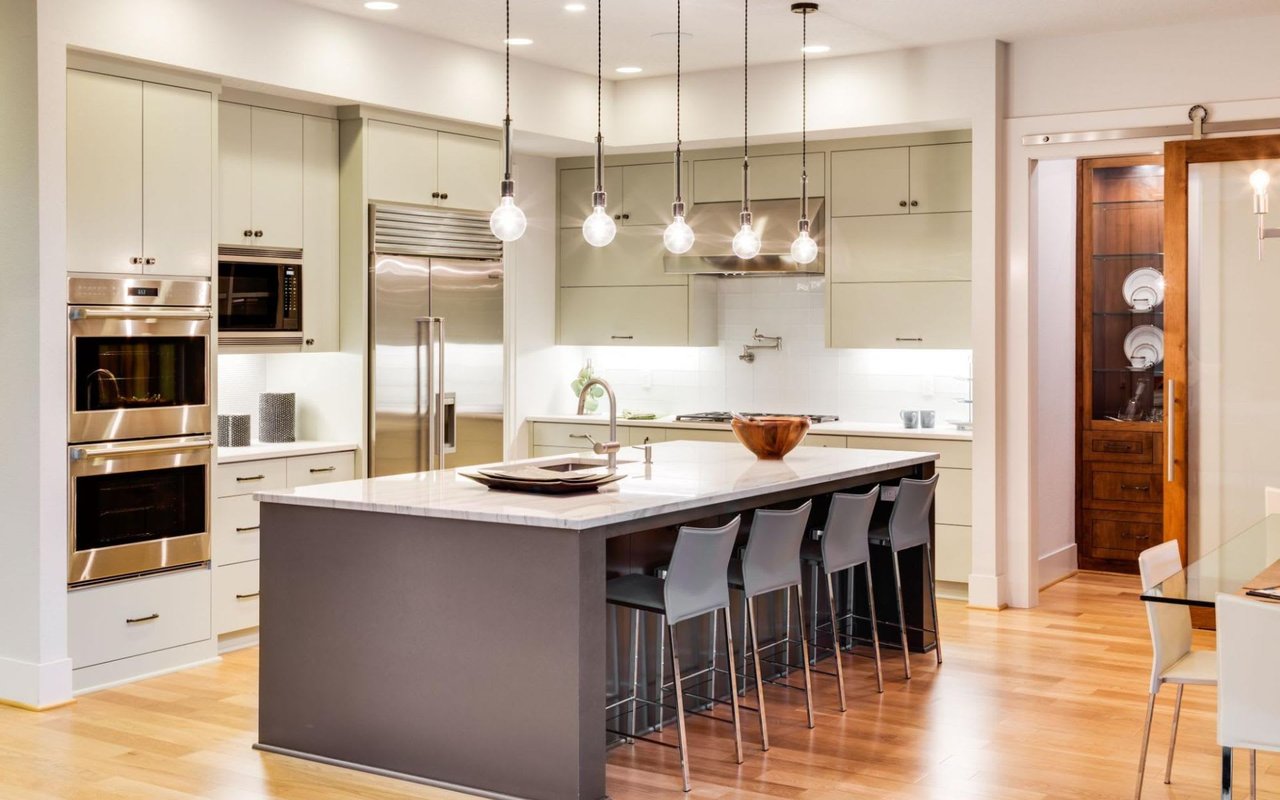The desert cities of the Coachella Valley are an oasis of high-end luxury living. Among the choices are nine major cities, including the sought-after destinations of Palm Springs, Palm Desert, Rancho Mirage, La Quinta, and Indian Wells, as well as countless smaller, close-knit neighborhoods and nearly 30 country clubs.
One of the biggest advantages to calling the Palm Desert region home is the area's near-infinite amount of resort lifestyle choices. From turn-key, move-in-ready residences to renovation and new construction opportunities, finding a home fit for your specific needs is easy. That proves especially true if you want to create a dream kitchen in the heart of your dream home—a place to cook, dine, and entertain.
An island of possibility
Contrary to popular belief, crafting a luxury kitchen is fairly straightforward.
Certainly, the abundance of high-end finishes to fit every taste and style for your floor, cabinets, countertops, and backsplash complicates your final aesthetic choices. Choosing between top-of-the-line appliance packages from respected brands such as La Cornue, Miele, Sub-Zero, Viking, and Wolf also carries its own challenges.
But unless you're doing a complete renovation, upgrading your kitchen occurs within a specific, finite space. The layout and existing structural elements, such as room transitions, doors, or windows, dictate the flow of particular components. You usually know where to place appliances, the sink, the cabinet, and the pantry.
Even with new construction, once you've dictated your wants and needs, the design of your kitchen is locked in place. Only minor tweaks are advisable once the basic layout begins to take shape.
The kitchen island, however, is different. Unmoored from any wall, the shape and structure of a kitchen island can take on any form and serve any purpose. Your only limitation is the square footage of your kitchen space, but in many cases, that simply promotes more creativity when designing an island.
Even if plumbed for water or gas or wired for electrical, the freestanding nature of the island offers complete flexibility. As a point of reference, the average kitchen island is 80 inches by 40 inches (slightly larger for open-concept kitchens), which can comfortably fit in a kitchen that measures between 150 and 175 square feet while seating four standard-size bar stools.
With that in mind, let's explore the specific considerations necessary to design a kitchen island with seating.
Take stock of your overall space
As a multi-functional space, a kitchen island is used as much for its utility as it is appreciated for its aesthetic. Assess your non-seating needs and how the island fits into your kitchen's overall layout.
Start by measuring the area to determine the island's maximum size that still provides a comfortable user experience. But ensure you accommodate for variables such as the clearance space for cabinet, pantry, oven, and refrigerator doors.
Additionally, maintain awareness of your kitchen's work triangle—the distance between your sink, range, and refrigerator. Maybe not a huge concern at the outset of designing an island with seating, but a poorly planned work triangle makes using your kitchen a chore.
Once you determine the largest island you can comfortably fit within your kitchen's square footage, you can concentrate on the specifics of your island's design and its potential seating configuration. To jump-start the process, consider the following questions:
-
What is the island's primary use? Food prep and morning meals? A gathering space for close family and friends? An area for entertaining and accommodating larger groups of guests?
-
How vital is additional storage? Should the focus remain on optimizing the seating space or creating an island that serves several purposes, including a primary storage space?
-
Will you have to accommodate a sink or range-top cooking surface and an overhead vent hood? Or built-in features such as shelving or a nook for a microwave, dishwasher, ice maker, small beverage, or wine refrigerator?
Answers to the above will help you determine the best potential layout for your island and the type of seating it can accommodate.
Determine your ideal seating capacity
Assessing your spatial needs will determine how many seats your new island accommodates. From as few as two seats to as many as your kitchen's square footage will reasonably fit, there is no one-size-fits-all answer, only the number that best serves your specific needs.
You'll want to put plenty of thought into your seating requirements now and in the future. When deciding seating capacity, consider the stools or chairs you might use and how they'll serve you, your family, your guests, and the overall space. For example, though more casual in appearance, backless stools tuck away out of sight when not in use. Stools and chairs with backs are less conspicuous, though they offer a more comfortable experience. Banquet or bench seating adds a cozy, high-end aesthetic to the kitchen, but you'll need a big space to pull it off. When planning your seating, counter height also factors into your island's overall size.
If you entertain regularly and account for other seating options, such as your dining room or additional breakfast nook, consider an island with at least four to six seats.
Shaping your island
When most people picture a kitchen island, they see a perfectly shaped rectangle. But with the only genuine guiding principle being the size of your kitchen, your island is limited only by your imagination.
While it's important to ensure your kitchen island and its seating are functional and serve your unique needs, there's no reason it can't also be an opulent centerpiece in your equally spectacular Greater Palms Springs home.
The shape of your island should complement the kitchen surrounding it, but you're not always bound by that requirement. From common or classic to contemporary or customized, there are several options to consider:
Rectangular
The most common island shape, rectangular islands combine the best elements of form and function. They allow for seating configurations on one or more sides while also providing ample space for storage, a sink, or a range top.
Square
Second in popularity to the rectangle islands, a square-shaped island evokes the classic design of a four-top dining table. Often ideal for similarly shaped kitchen spaces or those that require extra storage, you can include seating on all four sides without sacrificing the island's internal storage. Perfect for a home lacking a breakfast nook but wanting a space for casual dining.
Curved
In most circumstances, the curved island takes a rectangular or square-shaped island, adding a subtle arch or dramatic crescent to the proceedings. While the former is commonplace in homes where the kitchen and island sit at an angle to adjacent rooms, the latter regularly takes the form of a round tabletop or elegantly bowed banquet seating.
L-shaped
Often reserved for larger kitchen spaces, L-shaped islands are gaining popularity due to their vast configuration options. The L shape effectively creates an island of zones without any one area infringing on another. These include functional storage, large workspace, accommodation for a sink or range top, or in-island appliances such as a microwave, dishwasher, or mini beverage fridge. An L-shaped island's best feature is the banquette or bench seating allowance, which dramatically transforms your luxury kitchen into a high-end cafe.
T-shaped
The T-shaped island is a rectangular island featuring an added extension, often in the form of a square or rectangular dining table large enough to seat four to six people and as many as 10. Much like the L-shape island, a substantially sized kitchen is ideal, providing this sophisticated island setup the dramatic space it deserves.
U-shaped
Arguably the grandest of all island designs, U-shaped islands (utilizing either straight or curved edges) universally take the form of three-sided banquette seating on the inside of the U, while the counter and cabinet space outside the U serves as a massive, built-in buffet with endless functionality and food prep and service applications.
Design your dream island
Designing a kitchen island with seating is surprisingly thought-provoking. Creating a comfortable, welcoming space in the heart of your Palm Desert home requires you to consider what is functional and accommodating to your food preparation and hosting needs while crafting an aesthetically pleasing space. If you need help bringing those noble ideas together in a cohesive fashion, consider consulting with a professional designer before starting on the path of an enriching endeavor.
Ready to make a move?
Terri Munselle, a premier Palm Desert real estate agent, has spent 25+ years helping buyers and sellers in the Greater Palm Springs area, which encompasses Palm Springs Real Estate, Palm Desert Homes for Sale, Rancho Mirage Real Estate, La Quinta Houses for Sale, and Indian Wells Properties for Sale. Clients praise Terri and her team for their first-class service, unparalleled knowledge of the desert neighborhoods, and flawless attention to detail. Her knowledge and connections as a resident expert will be a tremendous asset to you. Contact Terri today.







































